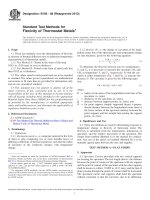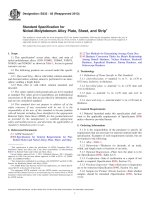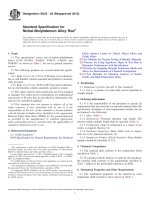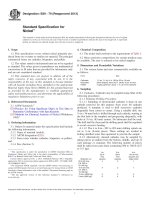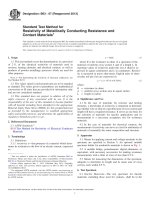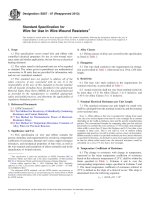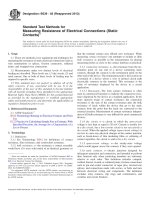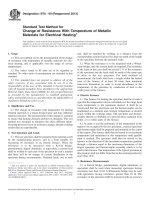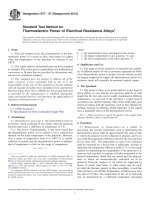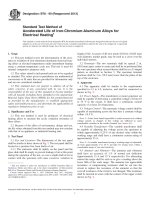Astm b 690 02 (2013)
Bạn đang xem bản rút gọn của tài liệu. Xem và tải ngay bản đầy đủ của tài liệu tại đây (95.42 KB, 5 trang )
Designation: B690 − 02 (Reapproved 2013)
Standard Specification for
Iron-Nickel-Chromium-Molybdenum Alloys (UNS N08366 and
UNS N08367) Seamless Pipe and Tube1
This standard is issued under the fixed designation B690; the number immediately following the designation indicates the year of
original adoption or, in the case of revision, the year of last revision. A number in parentheses indicates the year of last reapproval. A
superscript epsilon (´) indicates an editorial change since the last revision or reapproval.
E8 Test Methods for Tension Testing of Metallic Materials
E29 Practice for Using Significant Digits in Test Data to
Determine Conformance with Specifications
E1473 Test Methods for Chemical Analysis of Nickel,
Cobalt, and High-Temperature Alloys
1. Scope
1.1 This specification covers iron-nickel-chromiummolybdenum alloys (UNS N08366 and UNS N08367)* coldfinished annealed or hot-finished annealed seamless pipe and
tube intended for use in special corrosive service and for
heat-resisting applications.
3. Terminology
1.2 Pipe and tube shall be supplied in the solution heat
treated and descaled condition. When bright annealing is used,
descaling is not necessary.
3.1 Definitions of Terms Specific to This Standard:
3.1.1 average diameter, n—average of the maximum and
minimum outside diameters, or the maximum and minimum
inside diameters, as determined at any cross section of the tube.
3.1.2 pipe, n—seamless tube conforming to the particular
dimensions commercially known as standard pipe (Appendix
X1).
3.1.3 tube, n—hollow product of round or any other cross
section having a continuous periphery.
1.3 The values stated in inch-pound units are to be regarded
as standard. The values given in parentheses are mathematical
conversions to SI units that are provided for information only
and are not considered standard.
1.4 The following safety hazards caveat pertains only to the
test method portion, Section 12, of this specification. This
standard does not purport to address all of the safety concerns,
if any, associated with its use. It is the responsibility of the user
of this standard to become familiar with all hazards including
those identified in the appropriate Material Safety Data Sheet
(MSDS) for this product/material as provided by the
manufacturer, to establish appropriate safety and health
practices, and determine the applicability of regulatory limitations prior to use.
4. Ordering Information
4.1 It is the responsibility of the purchaser to specify all
requirements that are necessary for material ordered under this
specification. Examples of such requirements include, but are
not limited to, the following:
4.1.1 Quantity (feet, metres, or number of lengths),
4.1.2 Form (seamless tube or pipe),
4.1.3 Name of material or UNS number,
4.1.4 Finish,
4.1.5 Dimensions:
4.1.5.1 Tube—Outside diameter, minimum wall thickness,
4.1.5.2 Pipe—Standard pipe size and schedule (Appendix
X1),
4.1.5.3 Length—Specified or random,
4.1.6 Certification, if required (Section 15),
4.1.7 Purchaser’s inspection, if required, (Section 13),
4.1.8 ASTM designation and year of issue, and
4.1.9 Samples for product analysis, if required.
2. Referenced Documents
2.1 ASTM Standards:2
A450/A450M Specification for General Requirements for
Carbon and Low Alloy Steel Tubes
B880 Specification for General Requirements for Chemical
Check Analysis Limits for Nickel, Nickel Alloys and
Cobalt Alloys
1
This specification is under the jurisdiction of ASTM Committee B02 on
Nonferrous Metals and Alloys and is the direct responsibility of Subcommittee
B02.07 on Refined Nickel and Cobalt and Their Alloys.
Current edition approved Feb. 1, 2013. Published February 2013. Originally
approved in 1981. Last previous edition approved in 2007 as B690 – 02 (2007).
DOI: 10.1520/B0690-02R13.
* New designation established in accordance with ASTM E527 and SAE S1086,
Practice for Numbering Metals and Alloys (UNS).
2
For referenced ASTM standards, visit the ASTM website, www.astm.org, or
contact ASTM Customer Service at For Annual Book of ASTM
Standards volume information, refer to the standard’s Document Summary page on
the ASTM website.
5. Chemical Composition
5.1 The material shall conform to the composition limits
specified in Table 1.
5.2 If a product (check) analysis is made by the purchaser,
the material shall conform to the permissible variations for
product (check) analysis in Specification B880.
Copyright © ASTM International, 100 Barr Harbor Drive, PO Box C700, West Conshohocken, PA 19428-2959. United States
1
B690 − 02 (2013)
TABLE 1 Chemical Requirements
Composition Limits, %
Element
Carbon
Manganese
Silicon
Phosphorus
Sulfur
Chromium
Nickel
Molybdenum
Nitrogen
IronA
Copper
A
TABLE 4 Permissible Variations in Outside Diameter, Pipe
Permissible Variations in Outside Diameter
N08366
N08367
0.035 max
2.00 max
1.00 max
0.040 max
0.030 max
20.00 to 22.00
23.50 to 25.50
6.00 to 7.00
...
remainder
0.030 max
2.00 max
1.00 max
0.040 max
0.030 max
20.00 to 22.00
23.50 to 25.50
6.00 to 7.00
0.18 to 0.25
remainder
0.75 max
Nominal Pipe Size in. (mm)
⁄ (3.2) to 11⁄2 (38.1) incl
Over 11⁄2 (38.1) to 4
(101.6) incl
Over 4 (101.6) to 8
(203.2) incl
Over 8 (203.2) to 18
(457.2) incl
Over 18 (457.2) to 26
(660.4) incl
Over 26 (660.4) to 34
(863.6) incl
Over 34 (863.6) to 48
(1219.2) incl
18
Iron shall be determined arithmetically by difference.
Plus
Minus
in.
mm
in.
mm
⁄
1⁄32
0.4
0.8
1 32
⁄
1⁄32
0.8
0.8
⁄
1.6
1 32
⁄
0.8
3 32
⁄
2.4
1 32
⁄
0.8
⁄
3.2
1 32
⁄
0.8
5 32
⁄
4.0
1 32
⁄
0.8
⁄
4.8
1 32
⁄
0.8
1 64
1 16
18
3 16
TABLE 2 Mechanical Properties of Pipe and Tube
Tensile strength,
min, ksi
(MPa)
Yield strength, 0.2 %
offset, min, ksi
(MPa)
Elongation in 2 in. or
50
mm, or 4D, min,%
Cold-Worked
Annealed N08366
Hot-Worked
Annealed
N08366
Cold-Worked or HotWorked Annealed
N08367
75 (517)
75 (517)
# 3⁄16
> 3⁄16
30 (206)
30 (206)
100 (670)
45 (310)
95 (655)
45 (310)
30
30
30
30
where:
S = allowable fiber stress for material in cold-drawn
condition, (1⁄4 × UTS.) 16 700 psi (1150 kPa),
P = hydrostatic test pressure, psi (or kPa),
D = outside diameter of the tube or pipe, in. (or mm), and
t = minimum wall thickness, in. (or mm), equal to the
specified wall thickness minus the permissible “minus”
wall tolerance, Table 3, or the specified minimum wall
thickness.
6.2.2 Any pipe or tube showing leaks during hydrostatic test
shall be rejected.
6.2.3 When so agreed upon between the purchaser and
manufacturer at the time of the purchase order, pipe or tube
may be treated to 11⁄2 times the allowable fiber stress of S in
6.2.1.
6.2.4 When specified by the purchaser, a nondestructive
electric test in accordance with Specification A450/A450M
may be used in place of or in addition to, the hydrostatic test.
TABLE 3 Permissible Variations in Outside DiameterA Tube
Outside Diameter, in. (mm)
Permissible Variations, in. (mm)
Plus
Minus
Hot-Finished Seamless Tubes
⁄ 0.4)
⁄ (0.4)
1⁄64 (0.4)
4 (101.6) and under
Over 4 (101.6) to 71⁄2 (190.5) incl
Over 71⁄2 (190.5) to 9 (228.6) incl
⁄ (0.8)
⁄ (1.2)
1⁄16 (1.6)
1 64
1 32
1 64
3 64
Cold-Finished Seamless Tubes
Under 21⁄2 (63.5)
21⁄2 (63.5) to 3 (76.2), excl
3 (76.2) to 4 (101.6), incl
Over 4 (101.6) to 71⁄2 (190.5), incl
Over 71⁄2 (190.5) to 9 (228.6), incl
0.010
0.012
0.015
0.015
0.015
(0.25)
(0.30)
(0.38)
(0.38)
(0.38)
0.010
0.012
0.015
0.025
0.045
7. Dimensions and Permissible Variations
(0.25)
(0.30)
(0.38)
(0.64)
(1.14)
7.1 Outside Diameter and Wall Thickness:
7.1.1 The permissible variations in the outside diameter and
wall thickness of pipe and tube shall not exceed those specified
in Table 3, Table 4, and Table 5.
7.1.2 Permissible variations given in Table 3, Table 4, and
Table 5 are applicable only to two dimensions.
A
These permissible variations include out-of-roundness. These permissible variations in outside diameter apply to hot-finished seamless, and cold-drawn seamless
tubes before other fabricating operations such as upsetting, swaging, expanding,
bending, or polishing.
6. Mechanical and Other Properties
7.2 Length—When pipe or tube is ordered cut-to-length, the
permissible variations in length shall be those specified in
Table 6 for tubes; the permissible variation in length for pipe
shall be plus 1⁄4 in. (6.4 mm), minus 0 in.
6.1 The material shall conform to the mechanical property
requirements specified in Table 2.
7.3 Straightness—Material shall be reasonably straight and
free of bends and kinks.
6.2 Hydrostatic Test:
6.2.1 Each pipe or tube with an outside diameter 1⁄8 in. (3.2
mm) and larger, or tubes with a wall thickness of 0.015 in.
(0.38 mm) and over, shall be tested by the manufacturer to an
internal hydrostatic pressure of 1000 psi (68.9 kPa) provided
that the fiber stress calculated in accordance with the following
equation does not exceed the allowable fiber stress, S, indicated
below:
S 5 ~ PD/2t !
8. Workmanship, Finish, and Appearance
8.1 The material shall be uniform in quality and condition,
smooth, commercially straight or flat, and free of injurious
imperfections.
9. Sampling
9.1 Lot Definition:
9.1.1 A lot for chemical analysis shall consist of one heat.
(1)
2
B690 − 02 (2013)
TABLE 5 Permissible Variations in Wall ThicknessA —Tube
Outside Diameter,
in. (mm)
Plus
4 (101.6) and under
Over 4 (101.6)
Wall Thickness, %
Over 0.095 (2.7) to
Over 0.150 (3.8) to
0.150 (3.8) in. (mm), incl
0.180 (4.6) in. (mm), incl
Minus
Plus
Minus
Plus
Seamless, Hot-Finished Tubes
35
0
33
0
35
0
33
0
Seamless, Cold-Finished Tubes
Plus
Minus
20
0
22
0
0.095 (2.7) in. (mm)
and Under
Minus
Plus
40
...
0
...
11⁄2 (38.1) and under
Over 11⁄2 (38.1)
Over 0.180 (4.6) in.
(mm)
Minus
28
28
0
0
A
These permissible variations in wall thickness apply only to tubes, except internal-upset tubes, as rolled or drawn, and before swaging, expanding, bending, polishing,
or other fabricating operations.
TABLE 6 Permissible Variations in LengthA —Tube
Method of
Manufacture
Seamless, hot-finished
Seamless, cold-finished
Outside Diameter,
in. (mm)
all sizes
under 2 (50.8)
2 (50.8) and over
possible, longitudinal strip specimens, or largest possible round
specimen prepared in accordance with Test Methods E8, shall
be used.
Cut Length, in. (mm)
Plus
Minus
3⁄16 (4.8)
0
1⁄8 (3.2)
0
3⁄16 (4.8)
0
12. Test Methods
A
These permissible variations in length apply to tubes before bending. They apply
to cut lengths up to and including 24 ft (7.3 m). For lengths over 24 ft (7.3 m) an
additional over-tolerance of 1⁄8 in. (3.2 mm) for each 10 ft (3.0 m) or fraction thereof
shall be permissible up to a maximum of 1⁄2 in. (12.7 mm).
12.1 Determine the chemical composition and mechanical
properties of the material, as enumerated in this specification,
in the case of disagreement, in accordance with the following
ASTM methods:
12.1.1 Chemical Analysis—Test Methods E1473.
9.1.2 Lots for mechanical testing and check analysis shall
consist of the material from one heat, in the same condition
(temper), and of the same specified size (excepting length) and
cross section.
12.2 Tension Test—Test Methods E8.
12.3 Determination of Significant Places—For purposes of
determining compliance with the specified limits for the
requirements of the properties listed in the following table,
round an observed or a calculated value as indicated, in
accordance with the rounding methods of Practice E29.
9.2 Test Material Selection:
9.2.1 Sampling for Chemical Analysis:
9.2.1.1 An analysis of each lot shall be made by the
manufacturer from a representative sample obtained during the
pouring of the heat or subsequent processing.
9.2.1.2 If samples for product (check) analysis are specified,
a representative sample shall be taken from each lot (see 9.1.2)
of finished material.
9.2.2 Sampling for Mechanical Testing—Samples of the
material to provide test specimens for mechanical testing shall
be taken from such locations in each lot (see 9.1.2) as to be
representative of that lot.
Requirement
Rounded Unit for Observed or Calculated Value
Chemical composition
nearest unit in the last righthand place of figures of
the specified limit
nearest 1000 psi (7 MPa)
Tensile strength
Yield strength
Elongation
nearest 1 %
13. Inspection
13.1 Inspection of the material shall be made as agreed upon
between the manufacturer and the purchaser as part of the
purchase contract.
10. Number of Tests and Retests
10.1 Chemical Analysis—One test per lot.
14. Rejection and Rehearing
10.2 Mechanical Tests—Tension tests—One test per lot.
14.1 Material that fails to conform to the requirements of
this specification may be rejected. Rejection should be reported
to the producer or supplier promptly and in writing. In case of
dissatisfaction with the results of the test, the producer or
supplier may make claim for a rehearing.
10.3 Nondestructive Test—Each piece in each lot (9.1.2).
10.4 Retests—If the specimen used in the mechanical test of
any lot fails to meet the specified requirements, an additional
specimen shall be taken from a different sample piece and
tested. The results of this test specimen shall meet the specified
requirements.
15. Certification
15.1 When specified in the purchase order or contract, a
producer’s or supplier’s certification shall be furnished to the
purchaser that the material was manufactured, sampled, tested,
and inspected in accordance with this specification and has
been found to meet the requirements. When specified in the
purchase order or contract, a report of the test results shall be
furnished.
11. Specimen Preparation
11.1 Tension test specimens shall be taken from the material
after final heat treatment and tested in the direction of
fabrication.
11.2 Whenever possible, all pipe and tube shall be tested in
full tubular size. When testing in full tubular size is not
3
B690 − 02 (2013)
16.2 Packaging—Each bundle or shipping container shall
be marked with the name or brand of the manufacturer, the
trade name of the material or UNS number, the letters ASTM,
the specification number, heat number, condition (temper), and
nominal size; gross, tare, and net weight; consignor and
consignee address; contract or order number; or such other
information as may be defined in the contract or order.
16. Product Marking
16.1 Material—The name or brand of the manufacturer, the
trade name of the material or UNS number, the letters ASTM,
the specification number, heat number, and nominal size shall
be legibly stenciled on each piece 1⁄2 in. (12.7 mm) and over in
outside diameter, provided the length is not under 3 ft (914
mm). The material marking shall be any method which will not
result in harmful contamination.
16.1.1 For material less than 1⁄2 in. (12.7 mm) in outside
diameter and material under 3 ft (914 mm) in length, the
information specified in 16.1 shall be either stenciled or
marked on a tag securely attached to the bundle or box in
which the tube is shipped.
17. Keywords
17.1 seamless pipe; seamless tube; UNS N08367
APPENDIX
(Nonmandatory Information)
X1. SCHEDULES OF COLD-FINISHED SEAMLESS PIPE
X1.1 The schedules of cold-finished, seamless UNS
N08366 pipe as given in Table X1.1 are regularly available.
Other schedules may be furnished, and the manufacturer
should be consulted. Table X1.1 is published for information
only.
TABLE X1.1 Pipe SchedulesA
Nominal Pipe Size
Outside Diameter
Nominal Wall Thickness
Schedule No. 5
Schedule No. 10
Schedule No. 40
Schedule No. 80
0.065
0.065
0.083
0.083
0.109
0.109
0.109
0.109
0.120
0.120
0.120
0.120
...
...
0.088
0.091
0.109
0.113
0.133
0.140
0.145
0.154
0.203
0.216
0.226
0.237
0.258
0.280
...
0.126
0.147
0.154
0.179
0.191
0.200
0.218
0.276
0.300
0.318
0.337
...
...
1.65
1.65
2.11
2.11
2.77
2.77
2.77
2.77
3.05
3.05
3.05
3.05
...
...
2.24
2.31
2.77
2.87
3.38
3.56
3.68
3.91
5.16
5.49
5.74
6.02
6.55
7.11
...
3.20
3.73
3.91
4.55
4.85
5.08
5.54
7.04
7.62
8.08
8.56
...
...
Inches
⁄
⁄
1⁄2
1⁄8
14
38
1
1 1⁄ 4
1 1⁄ 2
2
1 1⁄ 2
3
3 1⁄ 2
4
5
6
0.540
0.675
0.840
1.050
1.315
1.660
1.900
2.375
2.875
3.500
4.000
4.500
5.563
6.625
...
...
0.065
0.065
0.065
0.065
0.065
0.065
0.083
0.083
0.083
0.083
...
...
13.72
17.14
21.34
26.67
33.40
42.16
48.26
60.32
73.02
88.90
101.60
114.30
141.30
168.28
...
...
1.65
1.65
1.65
1.65
1.65
1.65
2.11
2.11
2.11
2.11
...
...
Millimetres
6.4
9.5
12.7
19.1
25.4
31.8
38.1
50.8
63.5
76.2
88.9
101.6
127.0
152.4
A
The pipe schedules shown above conform with standards adopted by the American National Standards Institute.
4
B690 − 02 (2013)
ASTM International takes no position respecting the validity of any patent rights asserted in connection with any item mentioned
in this standard. Users of this standard are expressly advised that determination of the validity of any such patent rights, and the risk
of infringement of such rights, are entirely their own responsibility.
This standard is subject to revision at any time by the responsible technical committee and must be reviewed every five years and
if not revised, either reapproved or withdrawn. Your comments are invited either for revision of this standard or for additional standards
and should be addressed to ASTM International Headquarters. Your comments will receive careful consideration at a meeting of the
responsible technical committee, which you may attend. If you feel that your comments have not received a fair hearing you should
make your views known to the ASTM Committee on Standards, at the address shown below.
This standard is copyrighted by ASTM International, 100 Barr Harbor Drive, PO Box C700, West Conshohocken, PA 19428-2959,
United States. Individual reprints (single or multiple copies) of this standard may be obtained by contacting ASTM at the above
address or at 610-832-9585 (phone), 610-832-9555 (fax), or (e-mail); or through the ASTM website
(www.astm.org). Permission rights to photocopy the standard may also be secured from the ASTM website (www.astm.org/
COPYRIGHT/).
5
